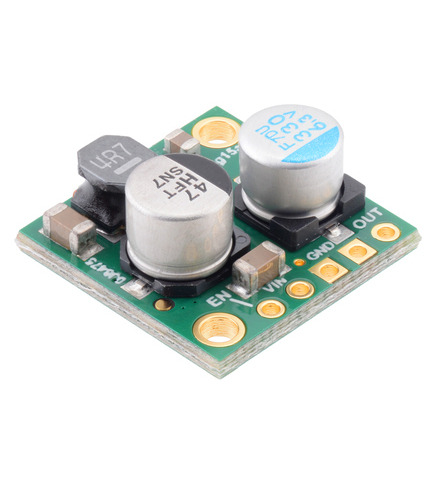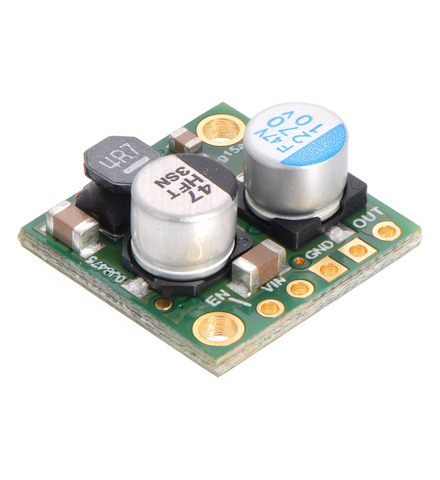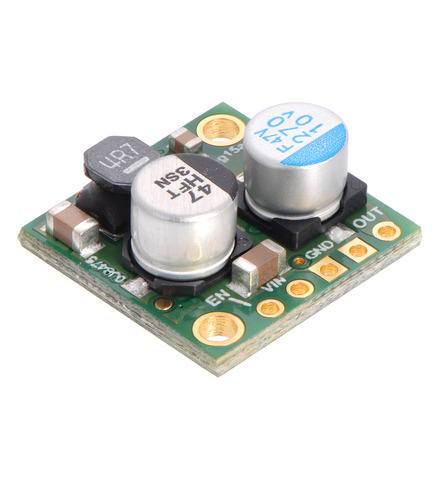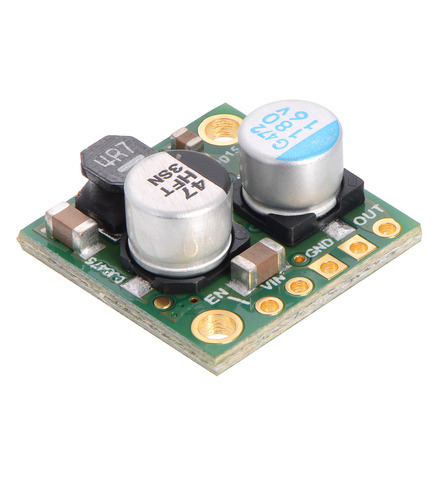Electronics » Regulators and Power Supplies » Step-Down Voltage Regulators »
D24V25Fx Step-Down Voltage Regulators
These compact synchronous, switching step-down voltage regulators generate lower output voltages from input voltages as high as 38 V. They offer typical efficiencies of 80% to 95% and continuous output currents up to 2.5 A.
Note: For newer, lower-priced step-down regulators with a similar input voltage range, output current, and size, consider the D24V22Fx family of regulators. Please note that while these D24V22Fx regulators look very similar to the D24V25Fx family of regulators, they do not have the same pinout and are based on a different internal design, so there are fundamental differences in operation. The D24V22Fx family also includes a 12 V option while the D24V25Fx family does not.
 Compare all products in this category
Compare all products in this category
Products in category “D24V25Fx Step-Down Voltage Regulators”
| Pololu item #: 2849 | |
| Brand: Pololu | supply outlook |
| Status: Rationed (Active) | |

|
|
This small synchronous switching step-down (or buck) regulator takes an input voltage of up to 38 V and efficiently reduces it to 3.3 V. The board measures only 0.7″ × 0.7″, but it allows a typical continuous output current of up to 2.5 A. Typical efficiencies of 80% to 95% make this regulator well suited for powering moderate loads like sensors or small motors. High efficiencies are maintained at light loads by dynamically changing the switching frequency, and an optional shutdown pin enables a low-power state with a current draw of a few hundred microamps.
| Pololu item #: 2850 | |
| Brand: Pololu | supply outlook |
| Status: Rationed (Active) | |

|
|
This small synchronous switching step-down (or buck) regulator takes an input voltage of up to 38 V and efficiently reduces it to 5 V. The board measures only 0.7″ × 0.7″, but it allows a typical continuous output current of up to 2.5 A. Typical efficiencies of 85% to 95% make this regulator well suited for powering moderate loads like sensors or small motors. High efficiencies are maintained at light loads by dynamically changing the switching frequency, and an optional shutdown pin enables a low-power state with a current draw of a few hundred microamps.
| Pololu item #: 2852 | |
| Brand: Pololu | supply outlook |
| Status: Rationed (Active) | |

|
|
This small synchronous switching step-down (or buck) regulator takes an input voltage of up to 38 V and efficiently reduces it to 6 V. The board measures only 0.7″ × 0.7″, but it allows a typical continuous output current of up to 2.5 A. Typical efficiencies of 85% to 95% make this regulator well suited for powering moderate loads like sensors or small motors. High efficiencies are maintained at light loads by dynamically changing the switching frequency, and an optional shutdown pin enables a low-power state with a current draw of a few hundred microamps.
| Pololu item #: 2853 | |
| Brand: Pololu | supply outlook |
| Status: Rationed (Active) | |

|
|
This small synchronous switching step-down (or buck) regulator takes an input voltage of up to 38 V and efficiently reduces it to 7.5 V. The board measures only 0.7″ × 0.7″, but it allows a typical continuous output current of up to 2.5 A. Typical efficiencies of 85% to 95% make this regulator well suited for powering moderate loads like sensors or small motors. High efficiencies are maintained at light loads by dynamically changing the switching frequency, and an optional shutdown pin enables a low-power state with a current draw of a few hundred microamps.
| Pololu item #: 2854 | |
| Brand: Pololu | supply outlook |
| Status: Rationed (Active) | |

|
|
This small synchronous switching step-down (or buck) regulator takes an input voltage of up to 38 V and efficiently reduces it to 9 V. The board measures only 0.7″ × 0.7″, but it allows a typical continuous output current of up to 2.5 A. Typical efficiencies of 85% to 95% make this regulator well suited for powering moderate loads like sensors or small motors. High efficiencies are maintained at light loads by dynamically changing the switching frequency, and an optional shutdown pin enables a low-power state with a current draw of a few hundred microamps.








